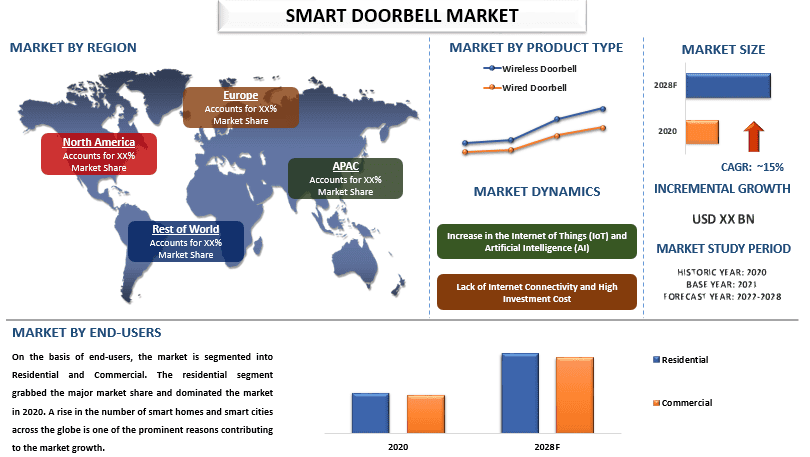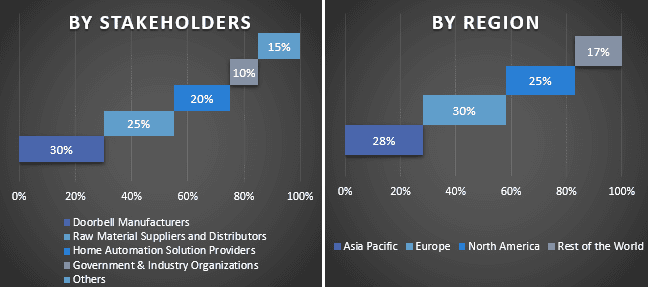
世界のスマートドアベル市場は、予測期間中に約15%の顕著な成長率で成長すると予想されています。消費者の所得の増加と不動産セクターの成長が相まって、スマートドアベルの需要増加に貢献する主な理由の1つです。さらに、スマートホームとスマートシティに対する需要の高まりも、スマートドアベルの市場成長を促進しています。都市化により、スマートシティは世界的に成長しており、これが成長を可能にしています。国連の予測によると、インドでは4億400万人、中国では2億9200万人、ナイジェリアでは2億1200万人の都市住民が2050年までに既存の人口に加わる見込みです。将来はより大きく、より多くの都市が存在するでしょう。1900年には世界の人口の10%が都市に住んでいましたが、今日では50%を超え、2050年までに75%に達するでしょう(ロンドン・スクール・オブ・エコノミクス、アーバンエイジプロジェクト)。政府の取り組みと支出も、独立したスマートソリューションと比較して、プラットフォームプロバイダーに多くの重要性を与えています。これは、他のスマートソリューションの拡張性と統合のためです。Consumer Technology Associationによると、世界規模でのスマートシティへの支出は、2050年には343億5,000万米ドルに達すると予想されています。
さらに、スマートホームデバイスに対する需要の増加も市場の成長に貢献しています。高速ブロードバンドの普及、5G接続の利用可能性、およびワイヤレスホームネットワークの増加により、スマートホームデバイスの世界市場は、2021年には2020年と比較して11.77%成長しました。IDCによると、スマートホームデバイスの世界市場は、2021年には2020年と比較して11.7%成長し、8億9500万台以上のデバイスが出荷されました。
Panasonic Corporation、Shenzhen VStarcam Technology Co., Ltd.、Ring Inc.、SkyBell Technologies Inc.、Legrand、Chui、Smartwares Group、Arlo Technologies Inc.、August Inc.、Danke Intelligent Technology Co Ltd.は、市場の主要プレーヤーの一部です。これらのプレーヤーは、ハイテクで革新的な製品/技術を顧客に提供するために、いくつかのM&Aとパートナーシップを行ってきました。
レポートに提示された洞察
「製品タイプの中で、無線カテゴリーは予測期間中に高いCAGRを記録する見込み」
製品タイプに基づいて、市場は有線ドアベルと無線ドアベルに分類されます。無線セグメントが主要な市場シェアを獲得し、2020年に市場を支配しました。ドアベルを移動するときに持ち運べる、チャイムをパーソナライズできる、自宅の他のスマートデバイスとの簡単な統合、モーション起動アラートの設定、携帯電話への直接通知の受信など、無線スマートドアベルに関連する利点が市場の成長に貢献しています。ワイヤレスオプションは、余分なコードを削減する洗練されたデザインを提供します。
「流通チャネルの中で、無線カテゴリーは予測期間中に高いCAGRを記録する見込み」
流通チャネルに基づいて、市場はオンラインとオフラインに分類されます。オフラインセグメントが主要な市場シェアを獲得し、2020年に市場を支配しました。スーパーマーケット、専門店などの増加が、このセグメントの市場成長に貢献する主な要因の1つです。一方、インターネット普及とスマートフォンの普及により、オンラインセグメントは今後数年間で最も高いCAGRを記録するでしょう。
「エンドユーザーの中で、住宅が2020年に市場で大きなシェアを占める見込み」
エンドユーザーに基づいて、市場は住宅と商業に分類されます。住宅セグメントが主要な市場シェアを獲得し、2020年に市場を支配しました。世界中のスマートホームとスマートシティの数の増加が、市場の成長に貢献する主な理由の1つです。
「アジア太平洋地域が市場で大きなシェアを占める見込み」
2020年、アジア太平洋地域は世界のスマートドアベル市場で大きなシェアを占めました。アジア太平洋地域が市場を支配し、2020年に主要な市場シェアを獲得しました。モノのインターネット(IoT)と人工知能(AI)の機能に関する進歩が加速したことで、メーカーは、家庭とビジネスの両方の環境での使用に適したスマートドアベルを開発しました。一方、北米も今後数年間でかなりのCAGRを記録するでしょう。
このレポートを購入する理由:
- この調査には、認証された主要業界専門家によって検証された市場規模と予測分析が含まれています。
- このレポートは、全体的な業界のパフォーマンスを簡単にレビューします。
- このレポートは、主要な事業財務、製品ポートフォリオ、拡張戦略、および最近の動向に焦点を当て、主要な業界関係者の詳細な分析をカバーしています。
- 業界で蔓延する推進要因、抑制要因、主要な傾向、および機会の詳細な検討。
- この調査は、さまざまなセグメントにわたる市場を包括的にカバーしています。
- 業界の詳細な地域レベル分析。
カスタマイズオプション:
世界のスマートドアベル市場は、要件またはその他の市場セグメントに応じてさらにカスタマイズできます。これらに加えて、UMIは、お客様が独自のビジネスニーズを持っている可能性があることを理解しており、お客様の要件に完全に適合するレポートを入手するために、お気軽にお問い合わせください。
目次
スマートドアベル市場分析(2022-2028)の研究方法
世界のスマートドアベル市場の歴史的市場を分析し、現在の市場を推定し、将来の市場を予測することが、世界中の主要地域でのスマートドアベルの採用を作成および分析するために行われた3つの主要なステップでした。歴史的市場数値を収集し、現在の市場規模を推定するために、徹底的な二次調査が行われました。次に、これらの洞察を検証するために、多数の調査結果と仮定が考慮されました。さらに、世界のスマートドアベル市場のバリューチェーン全体の業界専門家との徹底的な一次インタビューも実施されました。一次インタビューを通じて市場数値を仮定および検証した後、トップダウン/ボトムアップアプローチを採用して、完全な市場規模を予測しました。その後、市場細分化とデータ三角測量手法を採用して、業界のセグメントとサブセグメントの市場規模を推定および分析しました。詳細な方法は以下に説明します。
歴史的市場規模の分析
ステップ1:二次情報源の詳細な調査:
スマートドアベル市場の歴史的市場規模を取得するために、詳細な二次調査が実施されました。これには、次のような企業内部の情報源が含まれます。年次報告書および財務諸表、業績発表、プレスリリースなど、および次のような外部情報源:ジャーナル、ニュースと記事、政府発行物、競合他社の出版物、セクターレポート、サードパーティデータベース、およびその他の信頼できる出版物。
ステップ2:市場セグメンテーション:
スマートドアベル市場の歴史的市場規模を取得した後、主要地域のさまざまなセグメントとサブセグメントの歴史的市場洞察とシェアを収集するために、詳細な二次分析を実施しました。主要なセグメントには、製品タイプ、流通チャネル、エンドユーザーが含まれます。さらに、その地域でのテストモデルの全体的な採用を評価するために、国レベルの分析が実施されました。
ステップ3:要因分析:
さまざまなセグメントとサブセグメントの歴史的市場規模を取得した後、スマートドアベル市場の現在の市場規模を推定するために、詳細な要因分析を実施しました。さらに、スマートドアベルの製品、流通チャネル、エンドユーザーなどの従属変数と独立変数を使用して、要因分析を実施しました。世界のスマートドアベル市場における主要なパートナーシップ、合併と買収、事業拡大、および製品発売を考慮して、需要と供給側のシナリオについて徹底的な分析が実施されました。
現在の市場規模の推定と予測
現在の市場規模の算出:上記の3つのステップからの実用的な洞察に基づいて、現在の市場規模、世界のスマートドアベル市場の主要プレーヤー、およびセグメントの市場シェアに到達しました。必要なすべての割合シェア分割と市場細分化は、上記で述べた二次的なアプローチを使用して決定され、一次インタビューを通じて検証されました。
推定と予測:市場の推定と予測のために、推進要因と傾向、抑制要因、および関係者が利用できる機会を含むさまざまな要因に重みが割り当てられました。これらの要因を分析した後、関連する予測手法、つまりトップダウン/ボトムアップアプローチを適用して、世界中の主要市場にわたるさまざまなセグメントとサブセグメントについて2027年の市場予測に到達しました。市場規模を推定するために採用された調査方法は、以下を含みます。
- 主要市場における収益(米ドル)とスマートドアベル市場の採用率の観点からの業界の市場規模
- 市場セグメントとサブセグメントのすべての割合シェア、分割、および細分化
- 提供される製品の観点からの世界のスマートドアベル市場の主要プレーヤー。また、この急速に成長している市場で競争するために、これらのプレーヤーが採用している成長戦略
市場規模とシェアの検証
一次調査:主要地域の主要オピニオンリーダー(KOL)に対して詳細なインタビューを実施しました。これには、主要地域のトップレベルの幹部(CXO/VP、販売責任者、マーケティング責任者、運用責任者、地域責任者、カントリーヘッドなど)が含まれます。一次調査の結果を要約し、提示された仮説を証明するために統計分析を実施しました。一次調査からのインプットを二次的な結果と統合し、それによって情報を実行可能なインサイトに変換しました。
さまざまな地域の一次参加者の内訳

市場エンジニアリング
データトライアンギュレーション技術を採用し、市場全体の推定を完了し、グローバルスマートドアベル市場の各セグメントおよびサブセグメントについて正確な統計数値を導き出しました。データは、グローバルスマートドアベル市場における製品タイプ、アプリケーション、エンドユーザーのさまざまなパラメーターと傾向を調査した後、いくつかのセグメントとサブセグメントに分割されました。
グローバルスマートドアベル市場調査の主な目的
グローバルスマートドアベル市場の現在のおよび将来の市場動向を調査で特定しました。投資家は、調査で実施された定性的および定量的分析に基づいて、投資に関する裁量を決定するための戦略的インサイトを得ることができます。現在および将来の市場動向は、地域レベルでの市場全体の魅力を決定し、業界参加者が未開拓市場を最大限に活用してファーストムーバーアドバンテージから利益を得るためのプラットフォームを提供します。調査のその他の定量的目標には、以下が含まれます:
- スマートドアベル市場の現在のおよび予測市場規模を価値(USD)で分析します。また、さまざまなセグメントおよびサブセグメントの現在のおよび予測市場規模を分析します
- 調査のセグメントには、製品タイプ、アプリケーション、およびエンドユーザーの分野が含まれます。
- スマートドアベルの規制枠組みの定義と分析
- さまざまな仲介業者の存在に関連するバリューチェーンの分析と、業界の顧客と競合他社の行動の分析
- 主要地域におけるスマートドアベル市場の現在のおよび予測市場規模を分析します。
- レポートで調査された主要地域の国には、アジア太平洋、ヨーロッパ、北米、および世界のその他の地域が含まれます。
- スマートドアベル市場の企業プロファイルと、急成長する市場で持続するための市場プレーヤーが採用した成長戦略
- 業界の詳細な地域レベル分析
関連 レポート
この商品を購入したお客様はこれも購入しました










